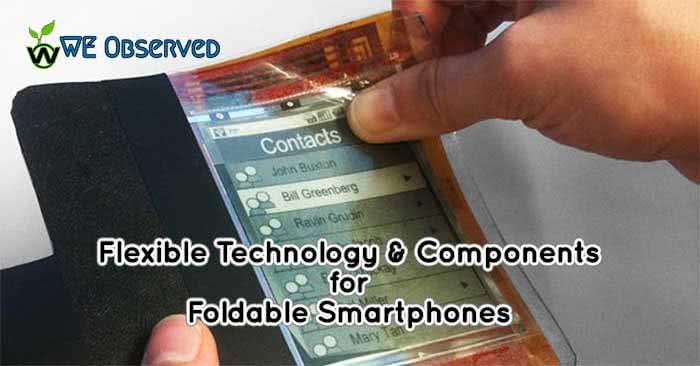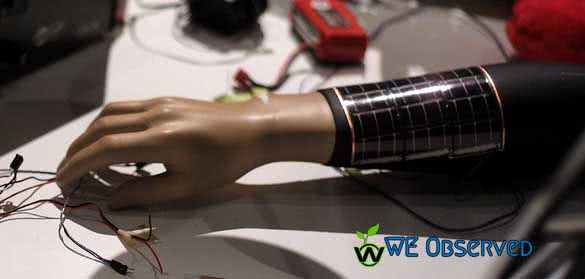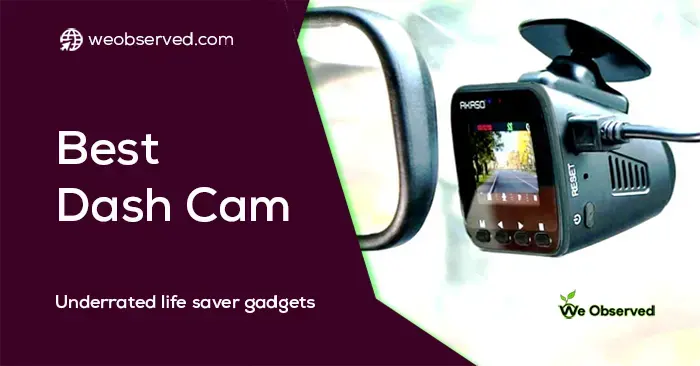Flexible phones, Foldable phones or Bendable Phones say whatever you want, but these smartphones and their release dates are one of the most trending topics nowadays. And all-Big companies and their researcher are working and patenting their research and invention regularly related to Flexible Technology.
You will find many Information on google just Search “foldable phone or flexible phone or flexible mobile phone”.If you want to know the upcoming Flexible Phones then there is Samsung Flexible Phone Galaxy X, Lenovo new phone CPlus flexible smartphone/smartwatch and the Folio foldable tablet/smartphone, LG Foldable Smartphone and there is also a NOKIA’s Unknown Foldable Smartphone.

As I already said that you will find many articles related to foldable phone on the internet, So we at We Observed have prepared a nice and long post to share information and little bit knowledge in the same field. Today in this post we will talk about Flexible Smartphone and technology behind it.
Flexible Technology and Flexible Electronics
Flexible technology is not a very old technique but it has recently expanded to a plethora of products. Basically, Flexible technology is a combination of different type of technology with an added quality which is Flexibility. So as electronics with flexibility is known as Flexible Electronics. Flexible electronics is a technology for assembling electronic circuits by mounting electronic devices on flexible plastic substrates, such as polyimide, PEEK or transparent conductive polyester film. Additionally, flex circuits can be screen printed silver circuits on polyester.
Flexible electronic assemblies may be manufactured using identical components used for rigid printed circuit boards, allowing the board to conform to the desired shape, or to flex during its use. An alternative approach to flexible electronics suggests various etching techniques to thin down the traditional silicon substrate to few tens of micrometres to gain reasonable flexibility, referred to as flexible silicon (~ 5 mm bending radius).
Also Check: How Best Plant-Powered Air Purifiers Cleans Air || Jabra Elite 65t Review
This technology is having many benefits like their lightweight, favourable dielectric properties, robust, high circuit density and conformable nature. Devices and circuits can be rolled away when not required. These types of devices offer properties like clarity, dimensional stability, low coefficient of thermal expansion, elasticity etc.
The flexible smartphone is a combination of flexible electronics components.So Flexible Smartphone is an example of Flexible Electronics Technology.
Parts of Flexible Electronics

In this part of the post, we will talk about the parts of Flexible Electronics, And starting with the flex circuit. There are a few basic constructions of flexible circuits but there is significant variation between the different types in terms of their construction. Following is a review of the most common types of flexible circuit constructions.
Types of Flex Circuits
- Single-sided flex circuits
- Double access or back bared flex circuits
- Sculptured flex circuits
- Double-sided flex circuits
- Multilayer flex circuits
- Rigid-flex circuits
- Polymer thick film flex circuits
Must Read: Cool Things You Can Do With Your Smartphone Camera || Amazfit Bip Lite Review
- Amorphous Silicon Technology
- Polysilicon Technology
- Organic Thin-Film Transistors
- Single Crystal Silicon on Flexible Substrates
- Mixed Oxide Thin-Film Transistors
- Hybrid (CMOS) Technology
Flexible circuit materials
- Base material: The base material is the flexible polymer film which provides the foundation for the laminate.
- Bonding adhesive: Many polyimide flex circuits presently employ adhesive systems of different polymer families. However, some newer thermoplastic polyimide adhesives are making important in-roads. As with the base films, adhesives come in different thickness. Thickness selection is typically a function of the application.
- Metal foil: A metal foil is most commonly used as the conductive element of a flexible laminate. The metal foil is the material from which the circuit paths are normally etched. A wide variety of metal foils of varying thickness are available from which to choose and create a flex circuit, however, copper foils, serve the vast majority of all flexible circuit applications. Copper’s excellent balance of cost and physical and electrical performance attributes make it an excellent choice.
Flexible Electronic Components

Fast flexible electronics operating at radio frequencies (>1 GHz) are more attractive than traditional flexible electronics because of their versatile capabilities, dramatic power savings when operating at reduced speed and a broader spectrum of applications. Transferrable single-crystalline Si nanomembranes (SiNMs) are preferred to other materials for flexible electronics owing to their unique advantages. Further improvement of Si-based device speed implies significant technical and economic advantages. While the mobility of bulk Si can be enhanced using strain techniques, implementing these techniques into transferable single-crystalline SiNMs has been challenging and not demonstrated.
Also Check: Boat Bassheads 225 Review || boAt bassheads 100 Review || Kindle Oasis 2019 Review
Circuit board
Flexible printed circuits (FPC) are made with photolithographic technology. An alternative way of making flexible foil circuits or flexible flat cables (FFCs) is laminating very thin (0.07 mm) copper strips in between two layers of PET. These PET layers, typically 0.05 mm thick, are coated with an adhesive which is thermosetting and will be activated during the lamination process.
Display
Research and development into flexible e-paper-based displays largely began in the late 2000s with the main intentions of implementing this technology in mobile devices. However, this technology has recently made an appearance, to a moderate extent, in consumer television displays as well. Read More:-Wikipedia – Flexible Display
Resistors and Capacitors
The structures of thin-film resistors and capacitors which are constructed on the flexible substrate and the conductive paths are made up of flexible materials such as silicon nanomembranes, graphene, carbon nanotubes etc. Nanotechnology is to a large extent for the manufacturing of electronic components
Must Check Inventions of: 2018 | 2017| 2016 | 2015
Memory, Amplifiers and Ring Oscillators
The researchers built three kinds of circuits to test the nanocrystal’s performance for circuit applications: an inverter, an amplifier, and a ring oscillator. All of these circuits were reported to operate with a couple of volts, according to the researchers an important point since If you want electronics for portable devices that are going to work with batteries, they have to operate at low voltage or they won’t be useful.
Batteries
The researchers presented a flexible thin-film lithium-ion battery that enables the realization of diverse flexible batteries regardless of electrode chemistry. The result is a flexible Li-ion battery that can be made with almost any electrode material. Here, the researchers used lithium cobalt oxide as the cathode material, which is currently the most widely used cathode in non-flexible Li-ion batteries due to its high performance. For the anode, they used traditional lithium.
Flexible/ Foldable/ Bendable Smartphones: –
So Basically Using All the above Flexible component and Technology Developer and researchers from the various group and company are trying to make various Flexible Devices/ Foldable Devices/Bendable Devices and Flexible or foldable Smartphone is one of them. Flexible or Foldable Smartphone will be based on Flexible electronics and either complete phone or just some pard will be foldable/bendable or flexible.
According to Wikipedia –
“In May 2011, Human Media Lab at Queen’s University in Canada introduced PaperPhone, the first flexible smartphone, in partnership with the Arizona State University Flexible Display Center.PaperPhone used 5 bend sensors to implement the navigation of the user interface through bend gestures of corners and sides of the display. In January 2013, the Human Media Lab introduced the first flexible tablet PC, PaperTab. Nokia introduced the Kinetic concept phone at Nokia World 2011 in London.At CES 2013, Samsung showcased the two handsets which incorporate AMOLED flexible display technology during its keynote presentation, the Youm and an unnamed Windows Phone 8 prototype device. Read More:-Wikipedia – Flexible Display.”
Upcoming Foldable Smartphone
Lenovo showed two prototype model at the Lenovo Tech World 2016. These two are:- CPlus flexible smartphone/smartwatch and the Folio foldable tablet/smartphone. They are actual product and not the concept video and images like Samsung Galaxy X Foldable Phone’s leaks. So we can say that maybe Lenovo is ahead from other companies like Samsung, Nokia, and LG in the field of Foldable Smartphone. When we talk about the release dates, According to Tech Advisor:- ” A Samsung Display Engineer has rained on Tech Advisor’s parade with the suggestion that the technology won’t mature until 2019.”
Check Also: Best Floor Lamps for Reading || Nokia 6.1 Plus Review || diib Review
Advantage and Disadvantage of Flexible/ Foldable/ Bendable Smartphone
Advantages
- lightweight
- Smaller dimensions required
- Space-saving
- Foldable and bendable
- Increased circuitry density
- Wide Viewing Angle
Disadvantages
- The initial investment may be expensive
- Integration of components would be a challenge for engineers
- Precision machines required
- Lifetime
Also Check: Boat Bassheads 225 Review || List of Best PayPal Alternatives
Conclusion
This field is growing and getting matured, it has been expanding rapidly and dynamically. This post is written to show you how the field of flexible/Foldable Electronics and Smartphone has evolved over the years and what the future holds for the large area, rugged, low power electronics. Some of the applications which can be developed on flexible substrates have been introduced. Development strategy of flexible electronics is dependent on global technological progress and market forecasts. Research and development are focused on big markets.
Flexible electronics covers a wide spectrum of applications including the flexible display, flexible solar cell, printed RFID, flexible lighting and others. Currently, it has been estimated that there are about 1500 worldwide research units working on various aspects of flexible electronics. The market analysis estimates the revenue of flexible electronics can reach 30 billion USD in 2017 and over 300 USD in 2028. So the future of foldable Smartphone is very bright and in maybe in the next 5 years, This technology will change the future of handheld devices.





